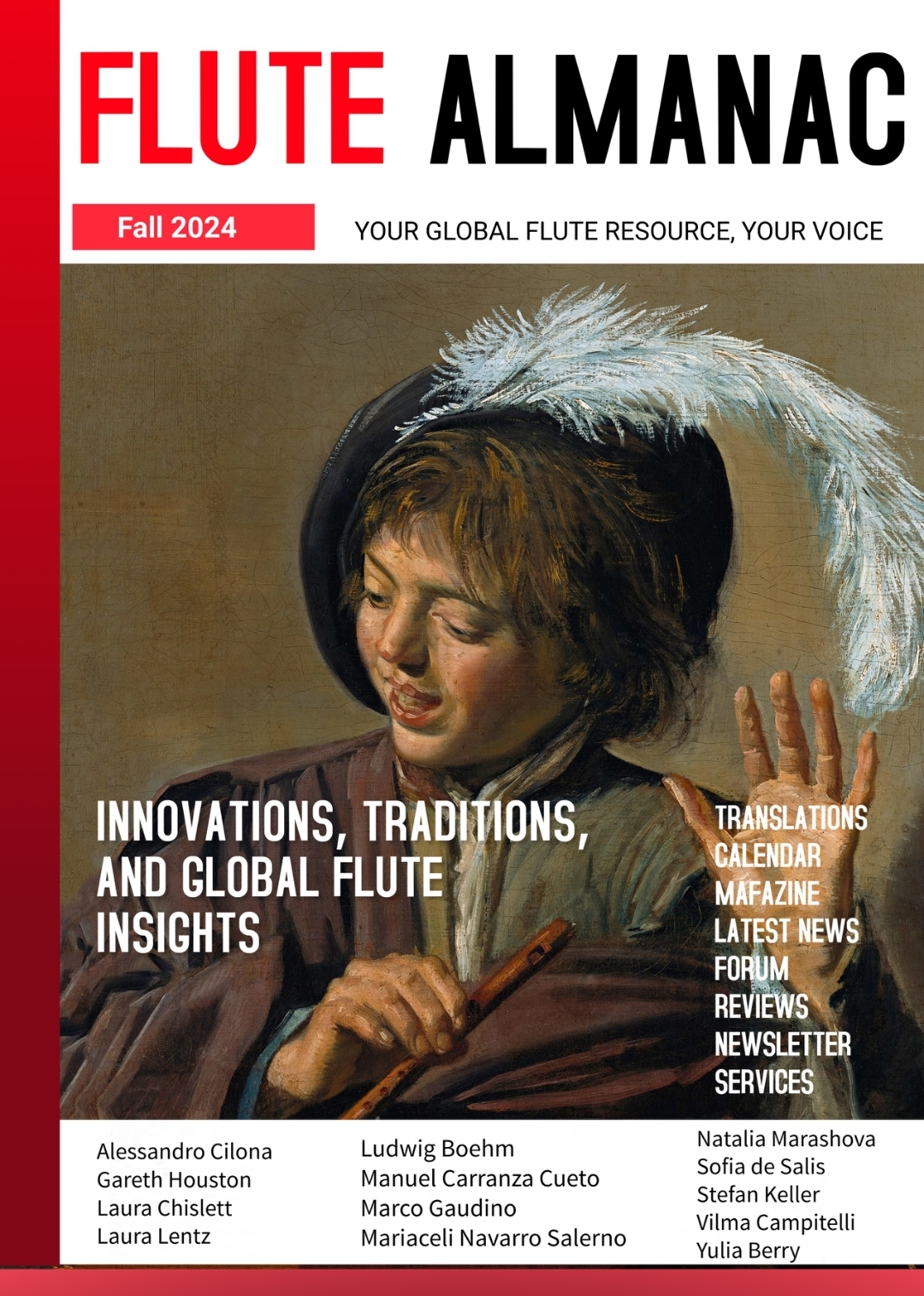
We are excited to present the first edition of Flute Almanac, the successor to The Babel Flute, continuing its mission of being a free and open platform that brings together a global community of flutists. In this inaugural edition, we are proud to feature 13 international authors from 9 different countries, showcasing a wide array of perspectives on the flute.
Flute Almanac takes a step forward from The Babel Flute by introducing new features, such as a Flute Calendar that highlights historical milestones and upcoming global events and comes with a free subscription feature, alongside reviews, newsletter, a forum for flute discussions, and constantly updated flute news. These additions make Flute Almanac not only a magazine but a dynamic resource for flutists worldwide.
The next edition will be released on December 15, and we invite flutists to submit their articles for consideration. Join us in continuing the rich tradition of sharing flute knowledge, experiences, and innovations from every corner of the world!
Note: If you are reading from your phone and cannot see all available languages in the translation button:
- Open your browser settings (three dots or lines on the top/bottom right).
- Select the desktop version.
- Click the translate button and select your language.
- Switch back to the mobile version in the settings. Your language choice will be remembered.
In this edition (click the titles):
The poetics of the transverse flute between the 17th and 18th centuries
In this article, Alessandro Cilona explores the rich poetics surrounding the transverse flute between the 17th and 18th centuries, tracing its origins in the court of Louis XIV and its profound influence on French musical theatre. From its first mentions in the works of Lully to its symbolic role in European operatic and visual arts, the transverse flute became a powerful vehicle for expressing complex emotions and gallant sentiments. By examining its presence in key compositions and cultural depictions, this article offers a deep dive into the flute’s artistic and emotional resonance during this fascinating period.
The Inline G Flute Podcast by Gareth Houston
Introducing The Inline G Flute Podcast to Flute Almanac readers – a bold new take on the flute world like you’ve never heard before. Hosted by Gareth Houston, this podcast flips the script on the traditional, polished image of the flute, diving into unexpected, edgy, and hilarious conversations. With weekly episodes ranging from deep dives into musical myths to candid talks with some of the world’s top flutists, it’s the podcast your mother never warned you about—but probably should have. Want to know what Gary Schocker, Zofia Neugebauer, and others really think after hours? Read the article, then tune in to find out!
Two Australian Flute Virtuosos by Laura Chislett
This article highlights the extraordinary careers of John Lemmoné and John Amadio, two influential Australian flutists who brought their music to audiences worldwide. The article explores their early beginnings, international performances, and their use of the unique Radcliff flutes. It also touches on their lasting influence on future generations of flutists, making them true legends of their time. Want to know more about their fascinating journey? Read on!
Spark a Sense of Discovery in Your Playing by Laura Lentz
This article encourages flutists to explore sound and creativity through her new warmup book, Modal Flute Warmup: Sound Discovery and Color Palette Expansion. Inspired by a simple Sam Baron exercise, the book helps flutists reflect on their sound, emotions, and technique, while offering opportunities for improvisation and technical growth. Whether you’re a student or teacher, this approach brings a fresh sense of discovery to your practice. Curious to learn more? Dive in!
Theobald Böhm as an Inventor in Other Fields by Ludwig Böhm
In this article, Ludwig Böhm reveals a side of Theobald Böhm that many may not know — his inventive genius beyond the flute. While he’s famous for revolutionizing the instrument, Böhm’s creativity extended into unexpected fields, from musical box production to industrial innovations. This fascinating glimpse into his lesser-known inventions promises to uncover yet another dimension of one of history’s greatest musical minds.
Northern Marinera on the Flute: ‘El Chalán’ by Manuel Carranza Cueto
This article explores the cultural significance and musical intricacies of the Northern Marinera, a traditional Peruvian dance, and its unique interpretation on the transverse flute through Manuel Carranza Cueto’s composition El Chalán, Op. 11. It delves into the origins, rhythm, and performance techniques of the Marinera, highlighting its fusion of Spanish and Afro-Peruvian influences. The article also discusses the use of the flute in interpreting this dynamic folk genre, illustrating how Carranza’s work captures the rhythmic essence and expressive nature of the Marinera in a modern flute quartet setting.
From Sound Production to the Role and Behavior of the Vocal and Respiratory Apparatus in the Flute: A Comprehensive Study (Parts 1-3) by Marco Gaudino
This article explores the principles of sound production in the flute, focusing on the aerodynamics and physiology involved. It examines the role of the respiratory system, vocal cords, and muscles in shaping the sound, explaining how airflow, pressure, and muscle control contribute to sound quality, pitch, and tone. The author also discusses the importance of proper muscle use, particularly the diaphragm, intercostal muscles, and vocal cords, in achieving a well-supported, resonant tone on wind instruments, with specific emphasis on the flute.
Strategies Used for Audition Preparation by Mariaceli Navarro Salerno
This article provides essential tips for preparing for music auditions. Mariaceli covers everything from study schedules, using techniques like Pomodoro and auditory imagination, to mindset practices such as meditation and breathing exercises. Mariaceli also emphasizes the importance of mock auditions, instrument maintenance, and managing external factors. With a focus on balancing mental, emotional, and physical well-being, this article offers a comprehensive guide to mastering the audition process. Curious to learn more? Read on!
A Rare Musical Duo Through the Centuries By Natalia Marashova
The combination of flute and mandolin is a rarity in concert programs, offering a unique and memorable sound. This article delves into the history of this uncommon duo, tracing its origins from the medieval and Renaissance eras to the Baroque period and beyond. It highlights key pieces from different eras and composers, showing how this duo has evolved and continues to inspire modern composers today. Through historical examples and contemporary works, the article encourages musicians to explore the rich potential of the flute and mandolin duet in classical music.
Voice dell’Anima: Music That Heals the Soul and Transcends Time by Sofia de Salis
This article explores the mystical power of music to heal and connect us to something beyond. Drawing from ancient traditions and modern science, Sofia shares how her unique flute technique creates soundscapes that evoke forgotten memories and transcend time. Through her collaboration with Kirill Bogomilov, they merge ancient Slavic and Native American motifs into an ethereal experience that invites listeners to pause, reflect, and heal. Want to discover how music becomes a bridge between worlds? Dive into the magic of Voice dell’Anima.
Flute Tuning: Rhino Flute Resonator by Stefan Keller
In this article, Stefan Keller shares his intriguing journey experimenting with the Rhino Flute Resonator, a unique invention by Roberto Feliciano Rolón. After installation by flute maker Dominik Roth, Keller noticed remarkable changes in his flute’s sound and responsiveness. Discover how this small adjustment brought a new level of resonance and depth to his playing, and the unexpected challenges he faced along the way. Curious about the final outcome? Read on to find out!
A Successful French Composer: Cécile Chaminade (1857-1942) by Vilma Campitelli
Cécile Chaminade was one of the most remarkable female composers of her time, achieving unprecedented success in the late 19th and early 20th centuries. As the first woman to be named Chevalier de la Légion d’Honneur in 1913, her influence reached far beyond her native France. Known especially for her Concertino Op. 107 for flute and piano, Chaminade composed over 400 works, captivating audiences worldwide. This article explores her groundbreaking career, her impact on the music world, and her lasting legacy as a pioneer for women in composition.
The Flute and Social Status: A Historical and Cultural Perspective by Yulia Berry
From ancient Egypt to European courts, the flute has been much more than just an instrument – it’s been a symbol of power, prestige, and sophistication. How did a simple woodwind become an emblem of royalty and high society? Explore the fascinating journey of the flute through history, from sacred rituals to luxurious instruments made of crystal and gold. Dive into the untold stories of how the flute shaped social hierarchies and continues to embody elegance and status today.
We invite all readers of the new Flute Almanac magazine to share their thoughts and insights in the comments. Your feedback, support, and sharing of this article help us continue delivering high-quality, flute-focused content. By engaging with the community, you contribute to the growth and success of Flute Almanac. Thank you for your continued support!







